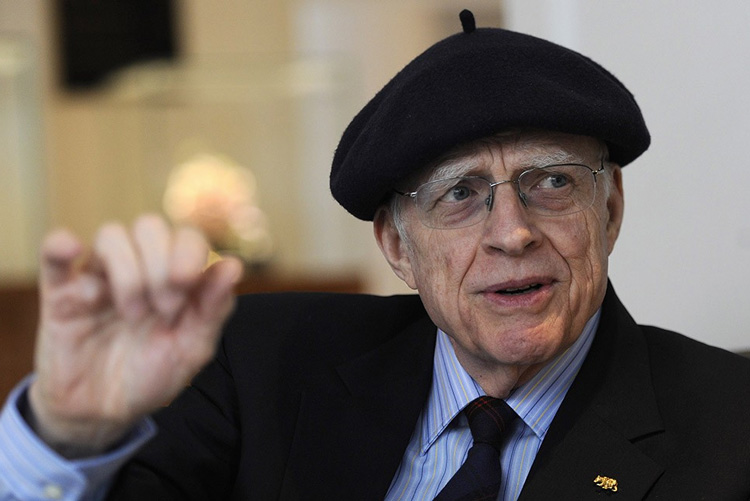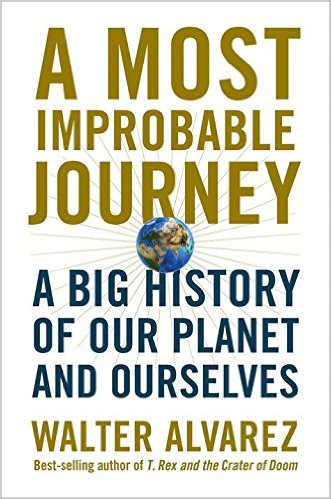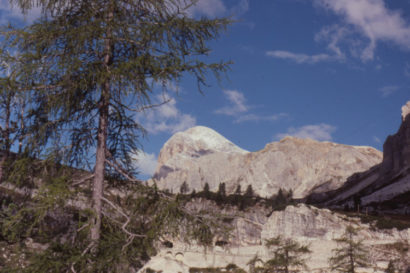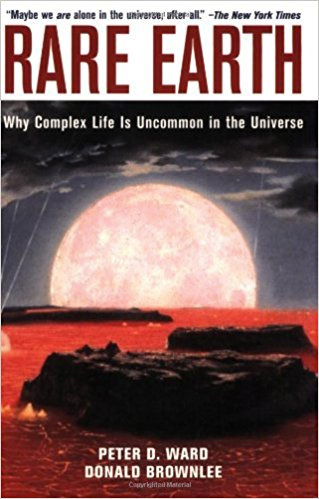Walter Alvarez: A geologist ponders the improbability of life
In his new book, the originator of the theory that a comet or asteroid killed off the dinosaurs discusses the origins of life itself

April 25, 2017
One-celled life – the earliest bacteria – arose on Earth some billion years after our planet formed. But it took another 3 billion years for these cells to learn to work together and start down the evolutionary road to multicellular life and, eventually, us.
Three billion years is a long time, even for a geologist like Walter Alvarez, who deals with Earth processes that take place over hundreds of millions of years. To him, today’s mountains, including his favorite, Italy’s Apennines, are an “ephemeral configuration” resulting from millions of years of shifting plates, uplift and volcanic eruptions, a history laid out today in rock outcrops he has learned to interpret.
But as Alvarez points out in his new book, A Most Improbable Journey: A Big History of Our Planet and Ourselves, the rise of multi-celled life was long and halting, with many false starts, and never guaranteed. An understanding of human history in light of the history of the cosmos, of Earth and of life in general makes it clear “just how unlikely our world is,” he writes.
“At innumerable points in (Earth’s) history,” he writes, “events could have led to totally different results – to a human situation completely different from what we know today or to a world with no humans at all.”
Through musings on rivers, glaciers, mountain ranges and continental shifts, Alvarez demonstrates the importance of geological processes in the movement of humans out of Africa, the development of technology and the exploration of the planet, among other human endeavors. In fact, he argues, all of human history was contingent on geological processes that could have gone much differently and altered the course of life on Earth.
 One reviewer likened the book to “a campfire chat with your favorite teacher sharing the biggest story you ever heard.”
One reviewer likened the book to “a campfire chat with your favorite teacher sharing the biggest story you ever heard.”
The book was inspired by a course Alvarez taught for five years, until his retirement in 2011, called “Big History,” in which he approached human history from a geologic and ultimately cosmic perspective, stretching back to the universe’s origin 13.8 billion years ago. The book is his attempt to make the scientific background of big history accessible to those without a science background, specifically historians and other humanists, through personal stories.
“The human situation in which we find ourselves is the result of a history that has unfolded across enormous stretches of time and space, and almost everything that has taken place in human history has been strongly influenced by events deeper in the past,” he writes.
This is Alvarez’s third book. In 1997, T. rex and the Crater of Doom was a bestseller, chronicling the research and insights that led him, his late father Luis Alvarez and their colleagues to propose that an asteroid or comet collided with Earth 66 million years ago and triggered the extinction of the dinosaurs and 70 percent of all other life on the planet. His 2008 book The Mountains of Saint Francis lovingly portrayed Italy’s billion-year geologic history and the Italian geologists who mapped it out.
Alvarez recently sat down to discuss his new book and its genesis.
Q: Why did you write this book?
Most of the people interested in big history are coming from a background in the humanities, maybe the social sciences, but not very many from the physical or biological sciences. It seemed to me that it would be valuable for people who were not from the sciences to see how somebody from that field thinks about it.
For example, there is that famous quote from Carl Sagan, “We are made of starstuff.” I add to that: “We are made of starstuff concentrated by Earth.” If you think about it, if you are out in an interstellar spacecraft and you need some silicon to make computer chips, you can’t just scoop it up as you go through, because it is so dilute. But Earth has been a chemical processing plant that concentrated all these different chemicals, not just silicon, but silver and gold and petroleum and coal and limestone and iron, everything. Earth just has this amazing virtuosity at concentrating things.
Sagan left out an important part. The book really is a geologist’s take on big history.
Q: How would you define big history?
I think of it as an interdisciplinary approach to bringing together everything we know about the past, or at least everything in the past that has led to human beings in our world.

The white Dolomite Mountains in Italy store vast amounts of carbon dioxide that otherwise would be in the atmosphere, heating up the Earth. The mountains were driven up over Europe when the Alps were formed. Walter Alvarez photo.
Dave Shimabukuro, who was my GSI (graduate student instructor) when we started the big history course, and I tried to get our students in the habit of using historical mindedness: Whatever you encounter you ask yourself, how did this come to be? What is the history that lies behind this?
For example, there is your cellphone sitting there. It has got glass across the front of it, so you ask yourself, where does glass come from? There is natural glass and artificial glass that people made, and mostly you get it by melting down quartz. So you ask, where did quartz come from? There wasn’t any quartz in the original Earth. It is made of silicon and oxygen, but silicon and oxygen were not around at the end of the Big Bang: all that got made inside of stars and then was blasted out by supenova explosions. That’s the first part of Carl Sagan’s quote. Then in the Earth, while there was silicon and oxygen, it originally was in other minerals, not quartz. The Earth had processes that gradually made quartz out of those things that were there. That is my addition to the Carl Sagan quote.
Q: Science has not typically been part of most history courses?
Early in the development of big history, which was started by David Christian, a history professor in Sydney, Australia, some people in history departments would say that science is not history: Where are the written documents? That view is fading, and I think it is becoming increasingly clear that many of the sciences are really historical sciences. Astronomy, cosmology, geology, paleontology, molecular genetics, paleoanthropology, archaeology — all are sciences interested in figuring out what happened in the past. We are just using different documents, not written by human hands but by natural processes.
Q: How did your students respond?
There must be lots of students who are happy to stay in whatever speciallty they are learning, but some are just dying to know how all these specialized courses fit together. Boy, did they love a class that talked exactly about that. The air was just electric in that class. I’ve never seen anything like it.
At the end of each semester, groups of students would pick out a topic to work on. One worked on dogs, all the way back to the origin of the universe and where carbon, which is critical in dogs and in us, came from. Another group wanted to study stilletto heels. I thought, this is going to be a little strange. But they convinced me it was going to be a good thing, and it was. They got into (the fact that) before people were concerned about public health, if you’re walking in a street with sewage running in it, it’s good to be wearing heels. And they talked about how you make stilletto heels, how you understand the physics of the stress.
Q: It sounds like you really changed the perspective of your students.
I think so, yeah. It certainly has changed my perspective. I can’t look at anything now without thinking about the history — it’s maybe a little distracting.
Q: Is the teaching of big history spreading, at Berkeley or around the world?
When I retired, I didn’t try too hard to find someone to replace me. It isn’t anything most professors want to teach, because you have to be really comfortable straying outside your field.
But I put on a (big history) conference where we invited people from the humanities to come and learn how geology works, and we all got so excited that we sat down and started the International Big History Association about four or five years ago, with Christian as the first president. Bill Gates also got excited about big history as a way to keep students interested in school, especially around ninth grade, when a lot of kids will drop out. He started the Big History Project.
I usually start a talk by asking how many people had heard of big history before the talk. Usually it’s small, one or two. Recently, I spoke to 200 people at the Commonwealth Club, and a dozen perhaps raised their hands. We’ve got some work to do.

Rare Earth, a book by Peter Ward and Donald Brownlee that argues life on Earth was a rare occurrence.
Q: Why the title, A Most Improbable Journey?
Because it seems very unlikely that the world we live in would ever have come into being, considering all the other possibilities. The best book about that is by Peter Ward and Don Brownlee at the University of Washington, called Rare Earth, in which they say that it may very well be that single-celled life is abundant in the universe, and may be around almost anywhere the conditions are right. But if you think about our planet, life probably started something like 4 billion years ago – we don’t know exactly – and it took 3 billion years before there were any multicelled oragnisms, and it has taken 4 billion years before you had any with the kind of intelligence that we have. So it is not at all clear that that is bound to happen.
Q: Given your book’s title, do you think it unlikely there is life elsewhere in the cosmos?
Yeah, I think so. People point out that there are an enormous number of planets out there, but we don’t know how long intelligent life will last in terms of years. We could do ourselves in at any time. If that were the case, then intelligent life, or at least technological life, might have lasted a few centuries out of 4.5 billion years. That makes it even more rare that it would be around right now.
If you think about how improbable we are, it makes you wonder whether we were destined to be here. That is a little bit of a disconcerting thought.

